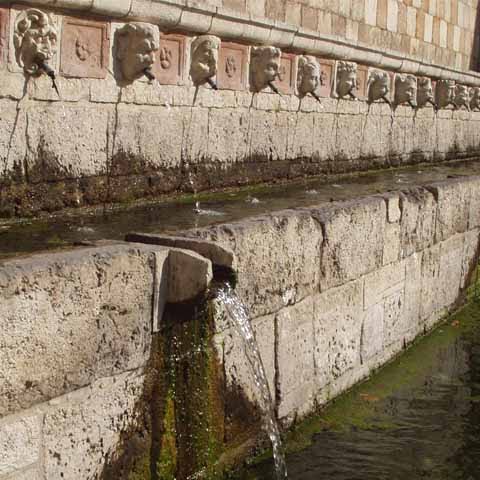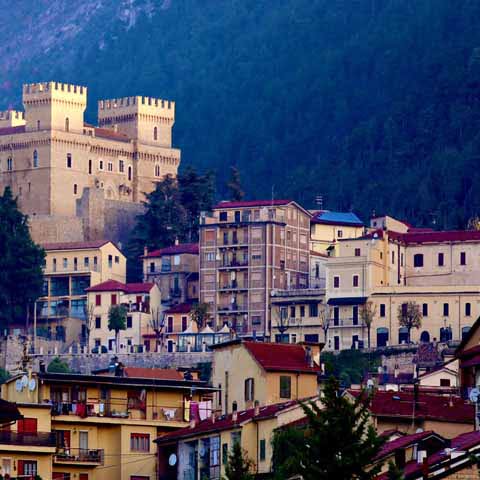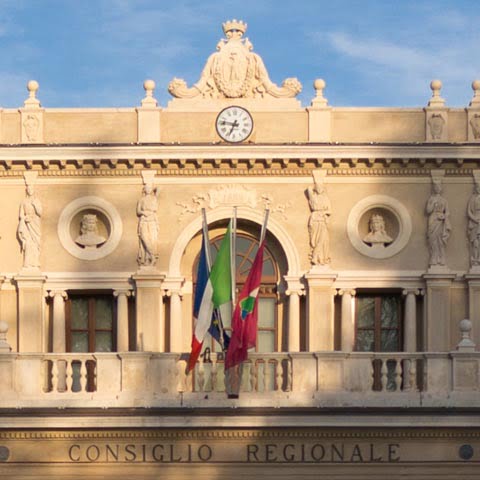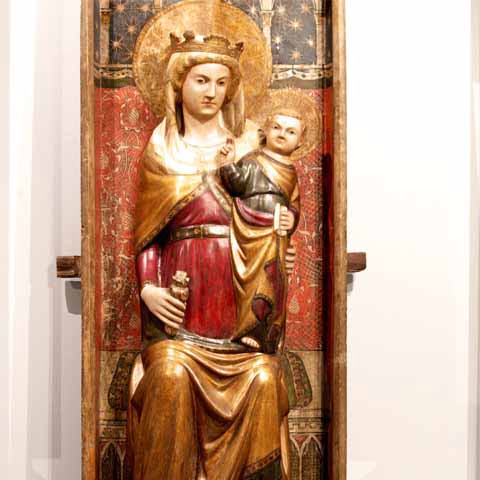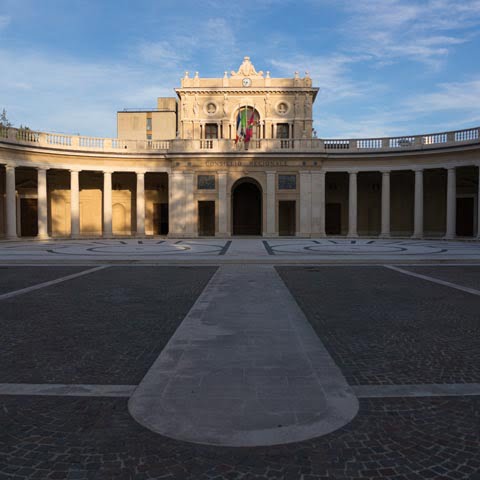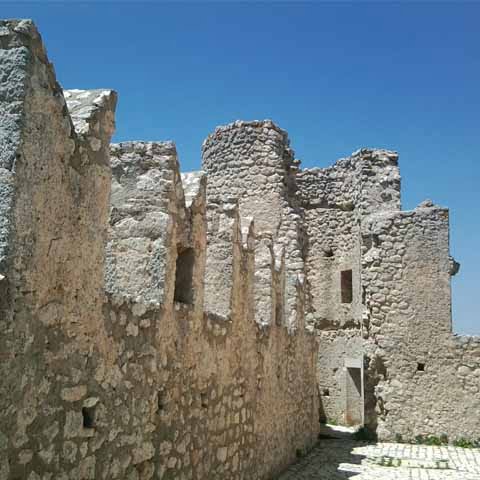Tucked into four main mountain peaks of the Apennine Mountains, is the enchanting city of L’Aquila. The town is a product of its ancient history over the centuries and happily strives to bring that Old World culture and tradition into today’s modern society. To take in the beautiful churches and works of art in the piazze is to lose yourself in the beauty of one of Italy’s best kept secrets.
ARCHITECTURE IN L’AQUILA
The city of L’Aquila is home to three main churches that each hold a special place in the town’s history: the Basilica of Santa Maria di Collemaggio, the L’Aquila Cathedral, and the Basilica of San Bernardino.
The main church of the city is referred to as L’Aquila Cathedral and is said to be dedicated to Saint Maximus of Aveia. The church was originally built in the thirteenth century and was restored after an earthquake in the early eighteenth century. Since that time the building has continued to receive periodic renovations. The cathedral is located in Piazza del Duomo amongst several other buildings, but its majestic muted white exterior with two bell towers and a Romanesque entryway of columns supporting a triangle allow it to easily stand out. The interior of the building showcases gorgeous paintings with Baroque influences and a great attention to detail. Unfortunately, the Duomo was severely damaged during the 2009 earthquake and remains inaccessible at the time of this publishing.
Just outside of the city is the Basilica of Santa Maria di Collemaggio, one of the largest churches in the Abruzzo region of Italy. The thirteenth century structure is a prime example of medieval architecture that combines Abruzzese Romanesque and Gothic styles. Late thirteenth century Pope Celestine V is said to have been crowned at the basilica itself, and his tomb now rests here. The box-shaped exterior of the building is a unique pattern of light and pink colored stone tiles that from a distance resembles a flower pattern. Three rose windows with sun-like patterns sit above three wooden doors that each have an ornate arched overhanging and entryway. There is one small tower off to the right of the building. The interior has a main center aisle made of a unique tile configuration and has wooden pews on each side. Elaborate arched entryways line either side of the church and lead up to a central archway that houses the altar, which is considered to be the front of the church. The basilica is a grand example of the stunning simplicity in which many churches in the area are made.
The Basilica of San Bernardino is a fifteenth century structure with a Renaissance style exterior. It is said to have taken almost twenty years to complete. The muted white color of the church is somewhat similar in appearance to that of the Basilica of Santa Maria di Collemaggio. From the exterior, the basilica appears to have three visible floors with a series of circular windows on the top two floors and three large wooden doors on the ground floor, with the central door being the largest and most grand in design. Inside, the basilica is home to several frescoes and decorative gilding and showcases a beautifully tiled floor made up of a series of unique designs. The church sustained considerable damage during the 2009 earthquake but re-opened in 2015.
Another popular religious building and sightseeing destination is the church of San Silvestro. This circa thirteenth or fourteenth century building is an integral part of the city’s religious history. Over the years the church has received several renovations due to damaging earthquakes. The white exterior is comprised of a quite simple Gothic style with one large rose window in the front and one bell tower on the right. The interior of the church has several naves and is home to some truly magnificent religious frescoes. After the 2009 earthquake, the church was re-opened in 2019 following restoration works.
Forte Spagnolo, translated as Spanish Fort, is an impressive sixteenth century castle found in the highest part of the city. It was originally built as a fortress, but over the years upkeep for the structure became cost prohibitive, which is why some parts of the castle were never completed. The castle is quite large in shape with a stunning stone bridge pathway leading to the main entrance. he National Museum of Abruzzo is actually located inside this castle.
Approximately five miles outside of the city is Amiternum. This once ancient city changed ownership many times over the years before slowly disintegrating. Parts of the city are still visible, including a partial amphitheater, theater, forum, and baths. Historians believe renowned historian Gaius Sallustius Crispus, sometimes referred to as Sallust, was born here in 86 BC. It is a beautiful but haunting experience to walk amongst the ruins and picture the city that thrived here hundreds of years ago.
ART IN L’AQUILA
Much of the culture and architecture of the city of L’Aquila naturally lends itself to fine art. So much so, in fact, that the Accademia di Belle Arti di L’Aquila (Academy of Beautiful Art) was established in the city in 1969.
One of the most impressive works of art in L’Aquila can be found in the Basilica of San Giuseppe Artigiano. A few years after the 2009 earthquake, the Archdiocese of L’Aquila commissioned renowned Italian painter Giovanni Gasparro for nineteen works of art for the basilica. It is considered to be the largest known painting cycle of sacred art made in this modern era.
Another work of art quite visible daily in Piazza Battagliona is the Fontana Luminosa or Luminous Fountain. In the middle of the fountain is a statue of two women holding a cauldron above their heads. The landmark is said to have been designed by Nicola D’Antino in the early twentieth century. While the fountain is breathtaking any time of day, colored lights that come on once darkness sets in makes the fountain really come to life. The other main fountain in L’Aquila is the Fountain of 99 Spouts, which has become a symbol of the city.
In the province of L’Aquila there is a great history of craftsmanship in the form of embroidery, lace making, and basketry. It would not be unusual to spot some talented individuals carrying on these traditions in the corner of one of the local city squares of L’Aquila.
LITERATURE
The beautiful mountain scenery combined with the solitude of the area is considered to be an ideal environment for aspiring writers. Historically, one of these writers was Laudomia Bonanni. A twentieth century Italian writer and journalist born in L’Aquila, Bonanni wrote Storie tragiche della montagna, Novelle d’Abruzzo (Tragic Stories from the Mountains. Novellas of Abruzzo), as well as some children’s books. She wrote for magazines and newspapers and seemed most drawn to writing about the marginalized and the oppressed of society.
MUSIC
New generations are studying music at The Alfredo Casella Conservatory of Music. The school offers both bachelor’s and master’s degrees in a variety of areas including music composition, conducting, vocal performance, instrumental performance, early music, and so much more.
Many members of the internationally renowned Abruzzo Symphonic Orchestra live in the city of L’Aquila. After the earthquake of 2009, some of these members began meeting and playing again to heal through the music. It was a great comfort for many of these musicians who then decided to give back to the people by performing open air concerts to lift people’s spirits.
The L’Aquila Concert Society hosts weekly concerts between October and May. In the summer, locals and visitors alike attend open-air concerts as well as theatrical performances and ballets.
CINEMA
The l’Istituto Cinematografico dell’Aquila was established in 1981 as an institute for production and awareness of cinematography in Italy and abroad. In the Province of L’Aquila about an hour from the city proper is Rocca Calascio, a picturesque mountaintop castle. The structure located in the Gran Sasso e Monti della Laga National Park can be spotted in movies such as Ladyhawke (1985), The Name of the Rose (1986), and The American (2010), starring George Clooney.
Other movies filmed in the province of L’Aquila include La roccia incantata (1950), D’Annunzio (1985), L’orizzonte degli eventi (2005), and L’amore non basta (2007),
SCIENCE
The province of L’Aquila is home to the world’s largest research center located underground, which is called Laboratori Nazionali del Gran Sasso. Part of the Italian National Institute of Nuclear Physics (INFN), the research facility focuses on particle physics, particularly neutrino research, and is positioned beneath the Gran Sasso mountain.
L’Aquila is bursting with culture in almost every corner of the city when you know where to look. To walk the streets of L’Aquila and take in the historical monuments is to fill the soul. Relax, breathe deeply, and let the warm people of the city show the beautiful mysteries and history that make a trip to L’Aquila so much more than just another vacation.
*SPECIAL NOTE: The city of L’Aquila continues to recover and rebuild from the 2009 earthquake, and sites and monuments listed above are described prior to the earthquake.
Don't just see Italy, live it.
Your dream trip to Italy has never been closer
No more endlessly scrolling travel sites. Our travel experts will craft the perfect, one-of-a-kind trip just for you.

300+
DESTINATIONS
We offer more Italian destinations than any travel site. Do and see more with Trips 2 Italy.
1 (of a kind)
ITINERARIES
Because your dream trip to Italy should be designed for you, not for the masses.
100%
PEACE OF MIND
From flights and accommodations, to food and activities - we take care of every detail.
